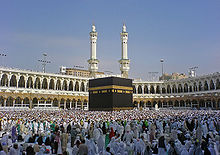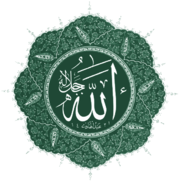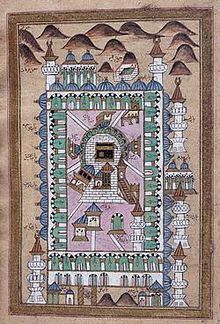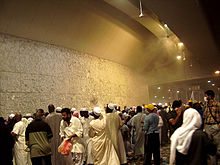- Hajj
-
 Pilgrims circumambulating the Kaaba during the Hajj
Pilgrims circumambulating the Kaaba during the Hajj
The Hajj (Arabic: حج Ḥaǧǧ "pilgrimage") is the pilgrimage to Mecca, Saudi Arabia. It is one of the largest pilgrimages in the world, and is the fifth pillar of Islam, a religious duty that must be carried out at least once in their lifetime by every able-bodied Muslim who can afford to do so.[1] The Hajj is a demonstration of the solidarity of the Muslim people, and their submission to God (Allah in the Arabic language).[2]
The pilgrimage occurs from the 8th to 12th day of Dhu al-Hijjah, the 12th and last month of the Islamic calendar. Because the Islamic calendar is a lunar calendar, eleven days shorter than the Gregorian calendar used in the Western world, the Gregorian date of the Hajj changes from year to year. Ihram is the name given to the special spiritual state in which Muslims live while on the pilgrimage.
The Hajj is associated with the life of Islamic prophet Muhammad from the 7th century, but the ritual of pilgrimage to Mecca is considered by Muslims to stretch back thousands of years to the time of Abraham (Ibrahim). Pilgrims join processions of hundreds of thousands of people, who simultaneously converge on Mecca for the week of the Hajj, and perform a series of rituals: Each person walks counter-clockwise seven times around the Kaaba, the cube-shaped building which acts as the Muslim direction of prayer, runs back and forth between the hills of Al-Safa and Al-Marwah, drinks from the Zamzam Well, goes to the plains of Mount Arafat to stand in vigil, and throws stones in a ritual Stoning of the Devil. The pilgrims then shave their heads, perform a ritual of animal sacrifice, and celebrate the three day global festival of Eid al-Adha.[3][4][5]
This article is part of the series: Islam 
Contents
History
The Kaaba during Hajj
The Hajj is based on a pilgrimage that was ancient even in the time of Muhammad in the 7th Century. According to Hadith, elements of the Hajj trace back to the time of Abraham (Ibrahim), around 2000 BCE. Abraham's wife, Sarah, was unable to conceive, and upon her request, Abraham had taken their female servant, Hagar, as a second wife. Hagar bore Abraham a son, Ishmael. It is believed that Abraham was ordered by God to leave Hagar (Hājar) and Ishmael (ʼIsmāʻīl) alone in the desert. Looking for shelter, food and water, Hagar ran back and forth between the hills of Safa and Marwa seven times with her son. In desperation, she laid the baby on the sand and begged for God's assistance. The baby cried and hit the ground with his heel (some versions of the story say that the angel Gabriel (Jibral) scraped his foot or the tip of his wing along the ground), and the Zamzam Well miraculously sprang forth.
Prior to Muhammad's era, each year tribes from all around the Arabian Peninsula would converge on Mecca, as part of the pilgrimage. The exact faith of the tribes was not important at that time, and Christian Arabs were as likely to make the pilgrimage as the pagans.[6] Muslim historians refer to the time before Muhammad as jahiliyyah, the "Days of Ignorance", during which the Kaaba contained hundreds of idols – totems of each of the tribes of the Arabian Peninsula, with idols of pagan gods such as Hubal, al-Lat, Al-‘Uzzá and Manat.
Muhammad was known to regularly perform the Umrah, even before he began receiving revelation.[3] Historically, Muslims would gather at various meeting points in other great cities, and then proceed en masse towards Mecca, in groups that could comprise tens of thousands of pilgrims. Two of the most famous meeting points were in Cairo and Damascus. In Cairo, the Sultan would stand atop a platform of the famous gate Bab Zuwayla, to officially watch the beginning of the annual pilgrimage.[7]
In 631 CE, Muhammad led his followers from Medina to Mecca, it was the first Hajj to be performed by Muslims alone, and the only Hajj ever performed by Muhammad. He cleansed the Kaaba, destroyed all the idols, and re-ordained the building as the house of God.[8] It was from this point that the Hajj became one of the Five Pillars of Islam.
Performing Hajj was a hazardous journey for early pilgrims; Ibn Jubayr noted the skeletons of pilgrims who had died of thirst during the journey. In the seventeenth century a group of Egyptian pilgrims lost over 1,500 people and 900 camels. In 1924 around one-fifth of a group of Syrian pilgrims died and two years later 12,000 are thought to have died during the journey.[9]
Preparations
See also: Ihram A 16th century illustration of Islam's holiest shrine the Kaaba.
A 16th century illustration of Islam's holiest shrine the Kaaba.
Pilgrims generally travel to Hajj in groups, as an expression of unity. Some airlines have special packages for Muslims going to Mecca such as the Haj subsidy offered in India. Ships also take pilgrims to Mecca so they can perform Hajj.
During the Hajj, male pilgrims are required to dress only in the ihram, a garment consisting of two sheets of white unhemmed cloth, with the top draped over the torso and the bottom secured by a white sash; plus a pair of sandals. Women are simply required to maintain their hijab - normal modest dress, which does not cover the hands or face.[10]
The Ihram is meant to show equality of all pilgrims, in front of God: there is no difference between a prince and a pauper. Ihram is also symbolic for holy virtue and pardon from all past sins. A place designated for changing into Ihram is called a miqat ( like Zu 'l-Hulafa, Juhfa, Qarnu 'l-Manāzil, Yalamlam, Zāt-i-'Irq, Ibrahīm Mursīa)
While wearing the Ihram, a pilgrim may not shave, clip their nails, wear perfume, swear or quarrel, have sexual relations, uproot or damage plants, cover the head [for men] or the face and hands [for women], marry, wear shoes over the ankles, perform any dishonest acts or carry weapons.
Rites
 The route the pilgrims take during the Hajj
The route the pilgrims take during the Hajj
Upon arrival in Mecca the pilgrim, now known as a Hajji,[11] performs a series of ritual acts symbolic of the lives of Ibrahim (or Abraham in English) and his wife Hajra (or Hagar in English). The acts also symbolize the solidarity of Muslims worldwide.
The greater Hajj (al-hajj al-akbar) begins on the eighth day of the lunar month of Dhu al-Hijjah. If they are not already wearing it upon their arrival, pilgrims put on ihram clothing and then leave Mecca for the nearby town of Mina where they spend the rest of the day. The Saudi government has put up thousands of large white tents at Mina to provide accommodations for all the pilgrims.[4]
Tawaf
On the first day of the Hajj (the 7th day of the 12th month in other words, Dhu al-Hijjah), the pilgrims perform their first Tawaf, which involves all of the pilgrims visiting the Kabah and walking seven times counter-clockwise around the Kaaba. They may also kiss the Black Stone (Al Hajar Al Aswad) on each circuit. If kissing the stone is not possible because of the crowds, they may simply point towards the Stone on each circuit with their right hand. In each complete circuit a pilgrim says "In the name of God, God is Great, God is Great, God is Great and praise be to God" (Bism Allah Allahu Akbar, Allahu Akbar, Allahu Akbar wa lil Lahi Alhamd) with 7 circuits constituting a complete tawaf. The place where pilgrims walk is known as "Mutaaf". Only the first three shouts are compulsory, but almost all perform it seven times.
The tawaf is normally performed all at once. Eating is not permitted but the drinking of water is allowed because of the risk of dehydration. Men are encouraged to perform the first three circuits at a hurried pace, followed by four times, more closely, at a leisurely pace.[10]
After the completion of Tawaf, all the pilgrims have to offer two Rakaat prayers at the Place of Abraham (Muqaam Ibrahim), a site inside the mosque that is near the Kaaba. However, again because of large crowds during the days of Hajj, they may instead pray anywhere in the mosque.
Although the circuits around the Kaaba are traditionally done on the ground level, Tawaf is now also performed on the first floor and roof of the mosque because of the large crowd.
After Tawaf on the same day, the pilgrims perform sa`i, running or walking seven times between the hills of Safa and Marwah. This is a re-enactment of the frantic search for water for her son Ishmael by Abraham's wife's servant Hajar. As she searched, the Zamzam Well was revealed to her by an angel, who hit the ground with his heel (or brushed the ground with the tip of his wing), upon which the water of the Zamzam started gushing from the ground.[12] The back and forth circuit of the pilgrims used to be in the open air, but is now entirely enclosed by the Masjid al-Haram mosque, and can be accessed via air-conditioned tunnels. Pilgrims are advised to walk the circuit, though two green pillars mark a short section of the path where they are allowed to run. There is also an internal "express lane" for the disabled. The safety procedures are in place because previous incidents in this ritual have resulted in stampedes which caused the deaths of hundreds of people.
As part of this ritual the pilgrims also drink water from the Zamzam Well, which is made available in coolers throughout the Mosque. After the visit to the mosque on this day of the Hajj, the pilgrims then return to their tents.
Arafat
Main article: Mount ArafatThe next morning, on the eighth of Dhu al-Hijjah, the pilgrims proceed to Mina where they spend the night in prayer.
On the ninth day, they leave Mina for Mt. Arafat where they stand in contemplative vigil and pray and recite the Qur'an, near a hill from which Prophet Muhammad gave his last sermon, this hill is called Jabal Al Rahmah (The Hill of Forgiveness, Mount Arafat). This is known as Wuquf, considered the highlight of the Hajj. Pilgrims must spend the afternoon within a defined area on the plain of Arafat until after sunset. No specific rituals or prayers are required during the stay at Arafat, although many pilgrims spend time praying, and thinking about the course of their lives. A pilgrim's Hajj is considered invalid if they do not spend the afternoon on Arafat.[4]
Muzdalifah
 Pilgrims on Plains of Arafat on the day of Hajj
Pilgrims on Plains of Arafat on the day of Hajj
As soon as the sun sets, the pilgrims leave Arafat for Muzdalifah, an area between Arafat and Mina. Pilgrims spend the night sleeping on the ground with open sky, and in the morning they gather pebbles for the next day's ritual of the stoning of the Devil (Shaitan) after returning to Mina.
Ramy al-Jamarat
Main article: Stoning of the DevilAt Mina the pilgrims perform Ramy al-Jamarat, throwing stones to signify their defiance of the Devil. This symbolizes the trials experienced by Abraham while he was going to sacrifice his son as demanded by Allah. The Devil challenged him three times, and three times Abraham refused. Each pillar marks the location of one of these refusals. On the first occasion when Ramy al-Jamarat is performed, pilgrims stone the largest pillar known as Jamrat'al'Aqabah.[13] Pilgrims climb ramps to the multi-levelled Jamaraat Bridge, from which they can throw their pebbles at the jamarat. On the second occasion, the other pillars are stoned. The stoning consists of throwing seven pebbles.[4] Because of the crowds, in 2004 the pillars were replaced by long walls, with catch basins below to collect the pebbles.
Eid al-Adha
Main article: Eid al-AdhaAfter the Stoning of the Devil, the pilgrims perform animal sacrifices, to symbolize God having mercy on Abraham and replacing his son with a ram, which Abraham then sacrificed. Traditionally the pilgrims slaughtered the animal themselves, or oversaw the slaughtering. Today many pilgrims buy a sacrifice voucher in Makkah before the greater Hajj begins, which allows an animal to be slaughtered in their name on the 10th, without the pilgrim being physically present. Centralized butchers sacrifice a single sheep for each pilgrim, or a cow can represent the sacrifice of seven people. The meat is then packaged and given to charity and shipped to poor people around the world.[4] At the same time as the sacrifices occur at Mecca, Muslims worldwide perform similar sacrifices, in a three day global festival called Eid al-Azha.[14]
Tawaf az-Ziyarah
On this or the following day the pilgrims re-visit the Masjid al-Haram mosque in Mecca for another tawaf, to walk around the Kaaba. This is called the Tawaf az-Ziyarah or Tawaf al-Ifadah, which symbolizes being in a hurry to respond to God and show love for Him, an obligatory part of the Hajj. The night of the 10th is spent back at Mina.
On the afternoon of the 11th and again the following day the pilgrims must again throw seven pebbles at each of the three jamarat in Mina.
Pilgrims must leave Mina for Mecca before sunset on the 12th. If they are unable to leave Mina before sunset, they must perform the stoning ritual again on the 13th before returning to Mecca.
Tawaf al-Wida
Finally, before leaving Mecca, pilgrims perform a farewell tawaf called the Tawaf al-Wida. 'Wida' means 'to bid farewell'.[4]
Journey to Medina
Some pilgrims choose to travel to the city of Medina and the Al-Masjid al-Nabawi (Mosque of the Prophet), which contains Prophet Muhammad's tomb and Riad ul Jannah and also pay visit to the grave of Prophet Muhammad companion, Umhat ul Mominen and Ahl al-Bayt in Al-Baqi'.[15] The Quba Mosque and Masjid al-Qiblatain are also usually visited.[16]
Umrah
Main article: UmrahUmrah can be performed any time of year. it is optional for Muslims to do unlike regular hajj which is mandatory. It does not contain as many steps as hajj. To complete Umrah Tawaaf is to be completed as described above.
Attempts at suggesting significance
Attempts have been made to establish a connection between the act of tawaf and orbiting motions of heavenly bodies. It has been proposed, for example, that the act of tawaf closely resembles the shape of a galaxy when viewed from above (Muhammad Eusha, "Scientific Significance of Circling the Kaba", The Daily Sun, 11 February).[17] But this view has not been verified by qualified ulama.
Modern crowd-control issues
As of 2010, about three million pilgrims participate in this annual pilgrimage.[18][19] Crowd-control techniques have become critical, and because of the large numbers of people, many of the rituals have become more stylized. It is not necessary to kiss the Black Stone, but merely to point at it on each circuit around the Kaaba. Throwing pebbles was done at large pillars, which for safety reasons in 2004 were changed to long walls with catch basins below to catch the stones. The slaughter of an animal can be done either personally, or by appointing someone else to do it, and so forth.[10] But even with the crowd control techniques, there are still many incidents during the Hajj, as pilgrims are trampled in a crush, or ramps collapse under the weight of the many visitors, causing hundreds of deaths. Pilgrims can also go to Mecca to perform the rituals at other times of the year. This is sometimes called the "lesser pilgrimage", or Umrah. However, even if one chooses to perform the Umrah, they are still obligated to perform the Hajj at some other point in their lifetime if they have the means to do so.
Social effect of Hajj
Main article: Incidents during the HajjMalcolm X, an American human rights activist, describes the sociological atmosphere he experienced at Hajj as follows,"There were tens of thousands of pilgrims, from all over the world. They were of all colors, from blue-eyed blondes to black-skinned Africans. But we were all participating in the same ritual, displaying a spirit of unity and brotherhood that my experiences in America had led me to believe never could exist between the white and the non-white. America needs to understand Islam, because this is the one religion that erases from its society the race problem. You may be shocked by these words coming from me. But on this pilgrimage, what I have seen, and experienced, has forced me to rearrange much of my thought patterns previously held."
Due to lack of communication between more than three million pilgrims from all over the globe and the immensity of the gathering itself, there have been many incidents during the Hajj that have led to the loss of hundreds of lives. The worst of these incidents have usually occurred during the Stoning of the Devil ritual. During the 2006 Hajj on 12 January, 362 pilgrims died. Tramplings have also occurred when pilgrims try to run between the two hills known as Al-Safa and Al-Marwa. In 2006 there were some 600 casualties among pilgrims performing the Hajj. After these events, the Saudi government made improvements for pilgrims such as providing separate pathways for travelling to and from Al-Safa and Al-Marwa.
A 2008 study on the longer-term effect of participating in the Islamic pilgrimage found that Muslims' communities become more open after the Hajj experience. Entitled Estimating the Impact of the Hajj: Religion and Tolerance in Islam’s Global Gathering, a study conducted in conjunction with Harvard University's John F. Kennedy School of Government found that the Hajj experience promotes peaceful coexistence, equality, and harmony.[20] Specifically, the report states that the Hajj "increases belief in equality and harmony among ethnic groups and Islamic community and that "Hajjis (those who have performed the Hajj) show increased belief in peace, and in equality and harmony among adherents of different religions"
Number of foreign pilgrims by year
According to the Royal Embassy of Saudi Arabia, the following number of foreign pilgrims arrived in Saudi Arabia each year, to perform the Hajj[21]:
- 1920 - 58,584
- 1921 - 57,255
- 1922 - 56,319
- 1996 - 1,080,465[22]
- 1997 - 1,168,591[23]
- 1998 - 1,132,344[24]
- 2001 - 1,363,992[25]
- 2005 - 1,534,759[26]
- 2006 - 1,654,407[27]
- 2007 - 1,707,814[28]
- 2008 - 1,729,841[29]
- 2009 - 1,613,000[30]
- 2010 - 1,799,601[31]
- 2011 - 1,828,195[32]
See also
- Glossary of Islam
- List of largest peaceful gatherings in history
- Tourism in Saudi Arabia
- Le Grand Voyage
- Journey to Mecca
- Saudi Red Crescent Authority
Notes
- ^ Berkley Center for Religion, Peace, and World Affairs - Islam See drop-down essay on "Islamic Practices"
- ^ Dalia Salah-El-Deen, Significance of Pilgrimage (Hajj)
- ^ a b Karen Armstrong (2000,2002). Islam: A Short History. pp. 10–12. ISBN 0-8129-6618-x.
- ^ a b c d e f Anisa Mehdi, John Bredar (writers) (2003). "Inside Makkah" (video documentary). National Geographic.
- ^ BBC - Religion & Ethics - Eid el Azha
- ^ Armstrong, Jerusalem: One City, Three Faiths, p. 221. "Each year the tribes would assemble from all over the peninsula to take part in the arduous and intricate rites of the hajj pilgrimage, Christian Arabs alongside the pagans. By Muhammad's time, the Ka'bah was dedicated to the Nabatean deity Hubal and surrounded by effigies of the Arabian pantheon, but it may well originally have been the shrine of Allah, the high god."
- ^ Eyewitness Travel: Egypt. Dorlin Kindersley Limited, London. 2001, 2007. pp. 103. ISBN 978-0-75662-875-8.
- ^ In the Lands of the Prophet, Time-Life, p. 31
- ^ Islam in the World by Malise Ruthven. Page 2. Granta Publications, 2006 ISBN 1-86207-906-4
- ^ a b c Mohamed, Mamdouh N. (1996). Hajj to Umrah: From A to Z. Amana Publications. ISBN 0-915957-54-x.
- ^ "Guide to going to Mecca". BBC. http://www.bbc.co.uk/religion/religions/islam/practices/hajj_3.shtml. Retrieved December 8, 2008.
- ^ Sahih Bukhari, Volume 4, Book 55, Number 583
- ^ www.easyhajj.co.uk
- ^ BBC - Religion & Ethics - Eid al Azha
- ^ "Hajj". Royal Embassy of Saudi Arabia.. http://www.saudiembassy.net/issues/hajj/. Retrieved 2009-07-30.
- ^ A life that matters: a spiritual experience By Norani Noridin and Nordin Yusof - Page 32
- ^ http://www.daily-sun.com/?view=details&type=daily_sun_news&pub_no=125&cat_id=2&menu_id=37&news_type_id=1&index=3&archiev=yes&arch_date=11-02-2011
- ^ "Hajj attracts some 3 million pilgrims". UPI. November 16, 2010. http://www.upi.com/Top_News/World-News/2010/11/16/Hajj-attracts-some-3-million-pilgrims/UPI-21981289926713/. Retrieved November 18, 2010.
- ^ altmuslim - As Hajj begins, more changes and challenges in store
- ^ Estimating the Impact of the Hajj: Religion and Tolerance in Islam's Global Gathering
- ^ http://books.google.com/books/princeton?hl=en&q=statistics&vid=ISBN9780691026190&btnG.x=8&btnG.y=6#v=snippet&q=statistics&f=false
- ^ Royal Embassy of Saudi Arabia
- ^ "Record number of pilgrims arrive for 1417 Hajj". Royal Embassy of Saudi Arabia. 1997-04-15. http://www.saudiembassy.net/archive/1997/news/page208.aspx. Retrieved 2009-07-30.
- ^ "Final statistics for Hajj 1418 pilgrims". Royal Embassy of Saudi Arabia. 1998-04-08. http://www.saudiembassy.net/archive/1998/news/page352.aspx. Retrieved 2009-07-30.
- ^ "Successful culmination of Hajj 1421". Royal Embassy of Saudi Arabia. 2001-03-09. http://www.saudiembassy.net/archive/2001/news/page514.aspx. Retrieved 2009-07-30.
- ^ "Prince Abdulmajeed declares Hajj 1425 a success". Royal Embassy of Saudi Arabia. 2005-01-25. http://www.saudiembassy.net/archive/2005/news/page806.aspx. Retrieved 2009-07-30.
- ^ "More than 2.3 million pilgrims perform the Hajj this year". Royal Embassy of Saudi Arabia. 2006-12-30. http://www.saudiembassy.net/archive/2006/news/page5.aspx. Retrieved 2009-07-30.
- ^ "More than 1.7 million pilgrims have arrived in Saudi Arabia for the Hajj". Royal Embassy of Saudi Arabia. 2007-12-17. http://www.saudiembassy.net/archive/2007/news/page15.aspx. Retrieved 2009-07-30.
- ^ "Record number of pilgrims arrive for Hajj". Royal Embassy of Saudi Arabia. 2008-12-06. http://www.saudiembassy.net/affairs/recent-news/news12060801.aspx. Retrieved 2009-07-30.
- ^ "2,521,000 million pilgrims participated in Hajj 1430". Royal Embassy of Saudi Arabia. 2009-11-29. http://www.saudiembassy.net/latest_news/news11290904.aspx. Retrieved 2009-12-08.
- ^ "2.8 million pilgrims participated in Hajj 1431". Royal Embassy of Saudi Arabia. 2010-11-18. http://www.saudiembassy.or.jp/En/PressReleases/2010/20101118.htm. Retrieved 2010-12-28.
- ^ "2,927,717 pilgrims performed Hajj this year". Royal Embassy of Saudi Arabia. 2011-11-06. http://www.saudiembassy.net/latest_news/news11061102.aspx. Retrieved 2012-11-16.
References
- Colin Wilson (1996). Atlas of Holy Places & Sacred Sites. ISBN 978-0789410511.
- Anisa Mehdi (2009). [Mecca] (Liner notes). National Geographic. (English), (Spanish)
Further reading
- Bianchi, Robert R. (2004). Guests of God: Pilgrimage and Politics in the Islamic World. Oxford University Press. ISBN 978-0195171075.
- Hammoudi, Abdellah (2006). A Season in Mecca: Narrative of a Pilgrimage. Hill and Wang. ISBN 978-0809076093.
- Shariati, Ali (2005). HAJJ: Reflection on Its Rituals. Islamic Publications International. ISBN 1889999385.
- Trojanow, Ilija (2007). Mumbai To Mecca: A Pilgrimage to the Holy Sites of Islam. Haus Publishing. ISBN 978-1904950295.
External links
- E-Book: Hajj & Umrah - Journey of a Lifetime
- Hajj - The Pilgrimage - The most comprehensive resource available
- - Hajj Information Center - An online Hajj resource from IslamiCity
- Hajj - Excellent Resources by Haq Islam
- The Custodian of the Two Holy Mosques Institute of Hajj researches
- The official Saudi Arabian Ministry of Hajj website
- Mapping Faith: The Pilgrimage to Mecca - CNN interactive feature
- Virtual Hajj by PBS
- Time Magazine Photo Essay: The Hajj Goes High Tech
- Muslims Cast Stones On 3rd Day Of Hajj - slideshow at The Huffington Post
- Pakistan Hajj Policy 2010
- Sequence of Hajj explained through Google Earth
- Hadith on Hajj
- Complete Interactive Online Guide to Hajj including rites, rituals and duas
- Hajj (The Pilgrimage) Online version of the book "Hajj: Reflection on Its Rituals" by Dr. Ali Shariati
- Hajj, a Holy Perspective
Wikimedia Foundation. 2010.




